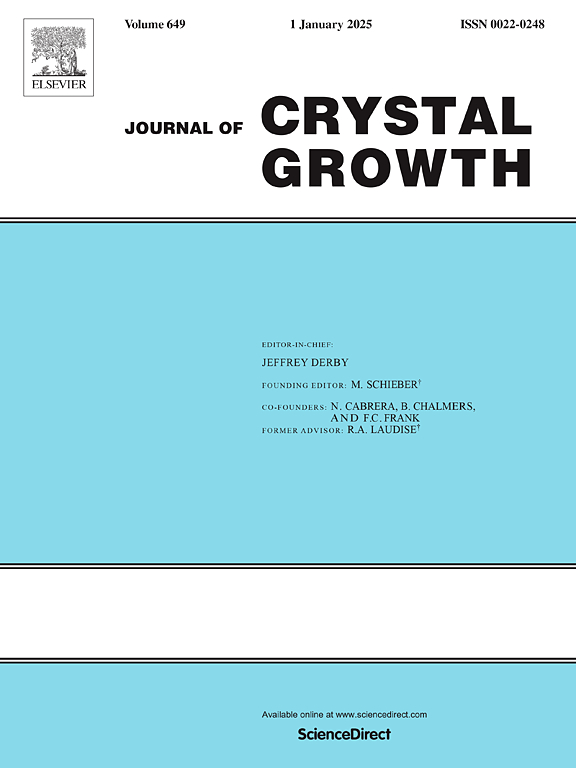Structural modulation of 2D and quasi-2D perovskite single crystals via ion doping
IF 1.7
4区 材料科学
Q3 CRYSTALLOGRAPHY
引用次数: 0
Abstract
Two-dimensional (2D) and quasi-2D perovskites have been extensively studied due to their enhanced environmental stability while retaining the excellent properties of three-dimensional (3D) perovskites. Herein, we prepared 2D and quasi-2D perovskite single crystals using space-confined solution method and re-precipitation method, respectively. Moreover, the structural modulation of prepared single-crystal perovskites (2D and quasi-2D) was explored through ion doping, which helps to thoroughly investigate the properties of perovskites. The results show that in (PEA)2Pb(Br1-xClx)4 perovskites, as the ratio of chloride ions to bromide ions increases, lattice distortion occurs, leading to exciton-phonon coupling and the transition from narrow-band emission to broadband emission. In (PEA)2(MA)n-1PbnBr3n+1 perovskites, MA+ can modulate the number of layers in (PEA)2(MA)n-1PbnBr3n+1, thereby precisely tuning the bandgap and controlling the emission range. The comprehensive study of doping in regulating the structure and properties of perovskite single crystals provides an important approach for precisely controlling their structure and properties for the potential applications in optoelectronic devices such as LEDs and photodetectors.

离子掺杂对二维和准二维钙钛矿单晶结构的调制
二维(2D)和准二维钙钛矿由于其在保持三维(3D)钙钛矿优异性能的同时增强了环境稳定性而得到了广泛的研究。本文分别采用密闭溶液法和重沉淀法制备了二维和准二维钙钛矿单晶。此外,通过离子掺杂研究制备的单晶钙钛矿(二维和准二维)的结构调制,有助于深入研究钙钛矿的性质。结果表明:在(PEA)2Pb(Br1-xClx)4钙钛矿中,随着氯离子与溴离子比例的增加,晶格发生畸变,导致激子-声子耦合,从窄带发射向宽带发射转变;在(PEA)2(MA)n-1PbnBr3n+1钙钛矿中,MA+可以调节(PEA)2(MA)n-1PbnBr3n+1钙钛矿的层数,从而精确调节带隙和控制发射范围。全面研究掺杂对钙钛矿单晶结构和性能的调控作用,为精确控制钙钛矿单晶的结构和性能提供了重要途径,为钙钛矿单晶在led、光电探测器等光电器件中的潜在应用提供了参考。
本文章由计算机程序翻译,如有差异,请以英文原文为准。
求助全文
约1分钟内获得全文
求助全文
来源期刊

Journal of Crystal Growth
化学-晶体学
CiteScore
3.60
自引率
11.10%
发文量
373
审稿时长
65 days
期刊介绍:
The journal offers a common reference and publication source for workers engaged in research on the experimental and theoretical aspects of crystal growth and its applications, e.g. in devices. Experimental and theoretical contributions are published in the following fields: theory of nucleation and growth, molecular kinetics and transport phenomena, crystallization in viscous media such as polymers and glasses; crystal growth of metals, minerals, semiconductors, superconductors, magnetics, inorganic, organic and biological substances in bulk or as thin films; molecular beam epitaxy, chemical vapor deposition, growth of III-V and II-VI and other semiconductors; characterization of single crystals by physical and chemical methods; apparatus, instrumentation and techniques for crystal growth, and purification methods; multilayer heterostructures and their characterisation with an emphasis on crystal growth and epitaxial aspects of electronic materials. A special feature of the journal is the periodic inclusion of proceedings of symposia and conferences on relevant aspects of crystal growth.
 求助内容:
求助内容: 应助结果提醒方式:
应助结果提醒方式:


